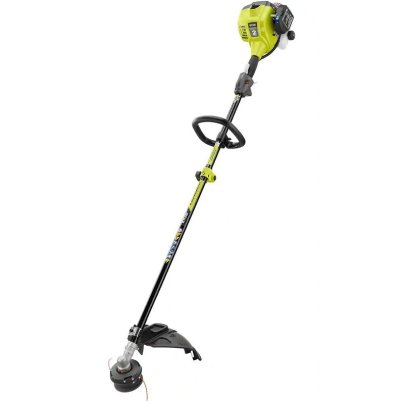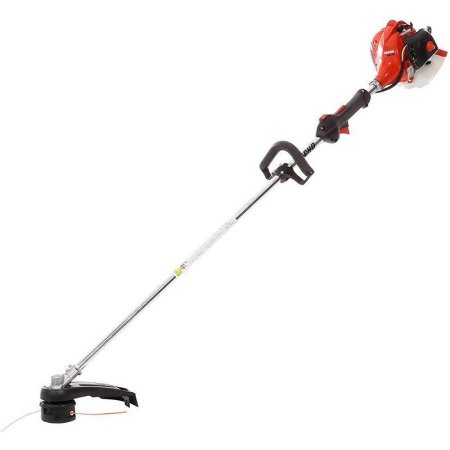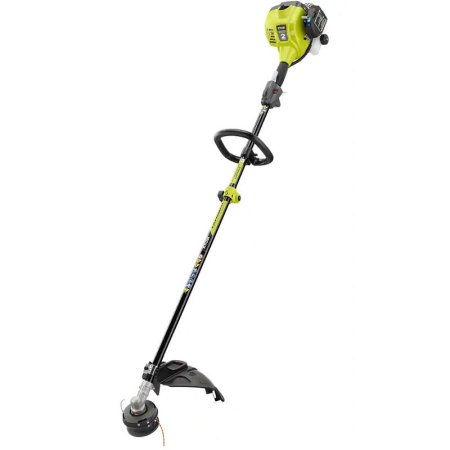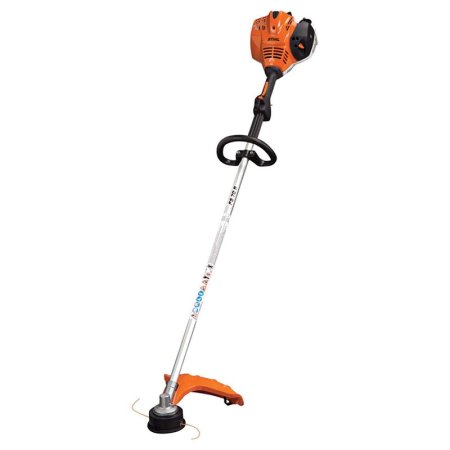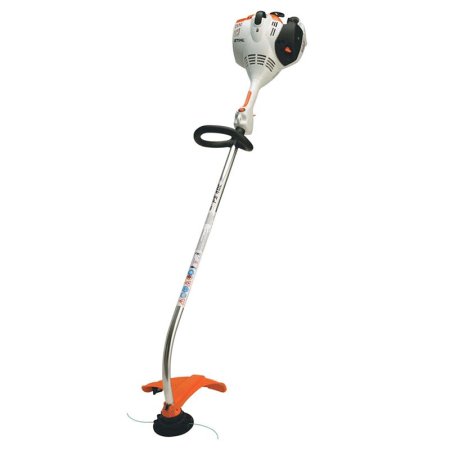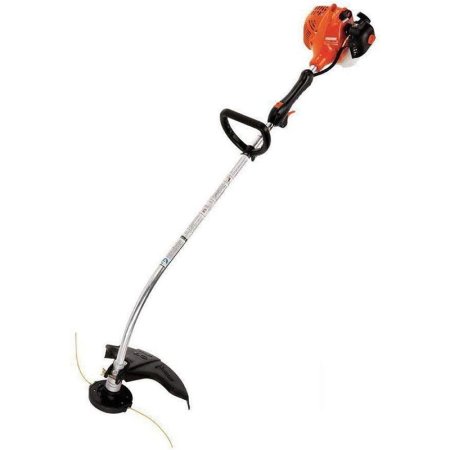
We may earn revenue from the products available on this page and participate in affiliate programs. Learn More ›
Grass and weeds can grow up the side of the shed, encroach on the garden, and climb the fence, but with a gas string trimmer—commonly called weed wackers—unwanted plants can quickly and efficiently be removed.
This garden tool is a helpful addition to a large yard or any location with a lot of different obstacles, like trees, lawn ornaments, fencing, garden beds, and small structures. While electric weed eaters may be a good choice for light trimming in small yards, gas string trimmers have the power that’s ideal for cutting through dense grass, weeds, and brush.
The best gas string trimmer for your yard will depend on several important factors, including cutting width, shaft type, and engine size. Our best overall string trimmer for its features is the Echo SRM-225i since it comes with a 21.2 cubic centimeter engine, i-75 ignition system, speed-feed head, and anti-vibration design.
Ahead, we discuss these and other important considerations that went into choosing the trimmers we tested for this article. Later on, we will also share more details on the individual models and how each one performed for us. The following list includes some of the best gas string trimmer tools available.
- BEST OVERALL: Echo SRM-225i
↓ Jump to Review - RUNNER-UP: Husqvarna 330LK Gas String Trimmer
↓ Jump to Review - BEST BANG FOR THE BUCK: Ryobi 2-Cycle Straight Shaft String Trimmer
↓ Jump to Review - BEST COMMERCIAL: Stihl FS 70 R Grass Trimmer
↓ Jump to Review - BEST CURVED-SHAFT: Husqvarna 130C Curved Shaft String Trimmer
↓ Jump to Review - BEST LIGHTWEIGHT: Stihl FS 40 C-E Gas String Trimmer
↓ Jump to Review - HONORABLE MENTION: Craftsman 25cc 2-Cycle Straight Shaft Gas Trimmer
↓ Jump to Review - ALSO CONSIDER: Echo GT-225 Curved Shaft String Trimmer
↓ Jump to Review
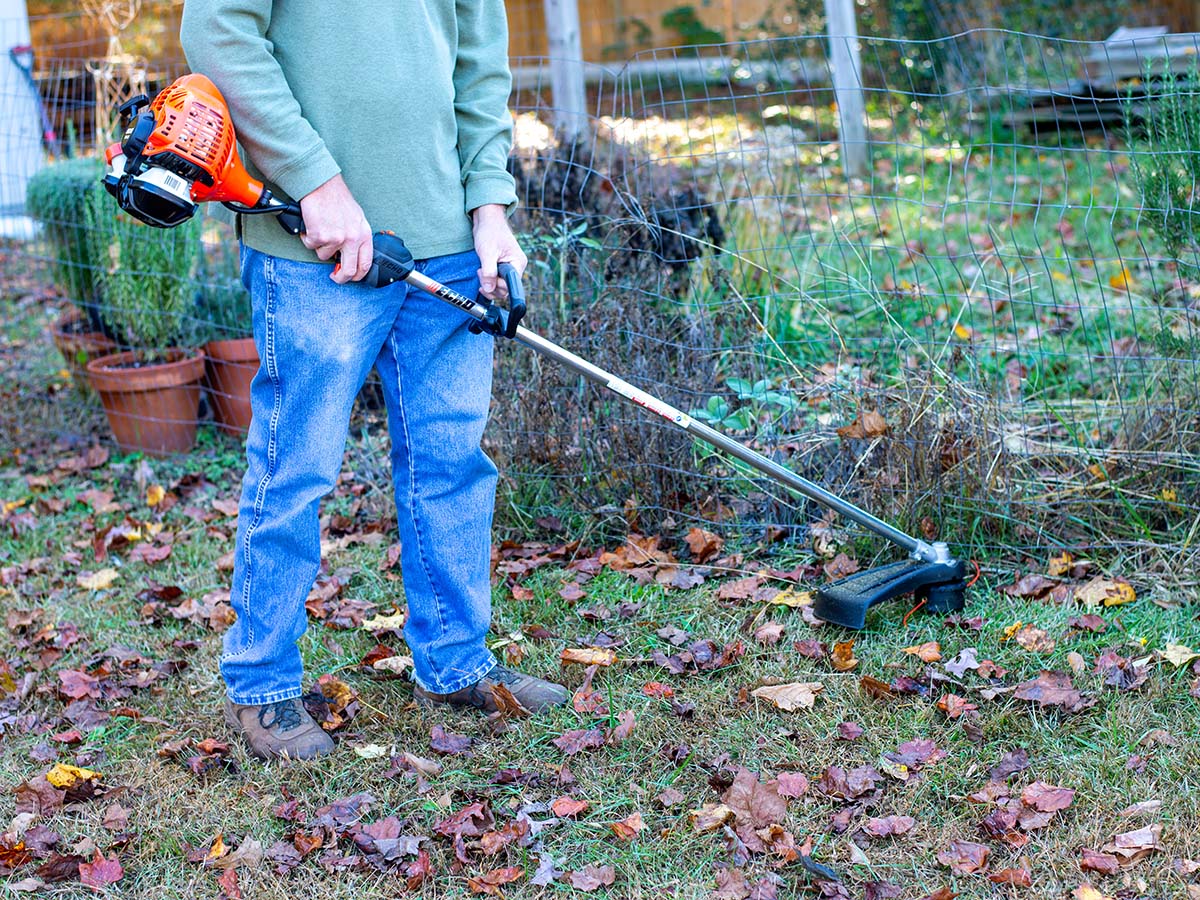
How We Tested the Best Gas String Trimmers
Shopping for a string trimmer reveals that statistics can only forward the search so far. Regardless of the engine size, machine weight, shaft length, and other measurables, much of the tool’s effectiveness depends on the operator’s physical build and personal preferences, along with the type of trimming to be done. To learn more about the trimmers on our list, we field-tested them in a variety of settings.
We spent 2 days testing the gas weed trimmers in this article on regular lawn trimming, close-quarters trimming among shrubs and perennials in landscape beds, and mowing an overgrown field. After unboxing and assembling each trimmer, we filled the fuel tank and got started.
Our initial notes included measurable and easily observable features, such as each machine’s physical size and weight, whether it had a straight or curved shaft, and whether or not it could be used with other tool attachments. The first operational tests were simply to start each machine and note the number of pulls required to get started.
We then used each machine for 30 minutes of field mowing and 15 minutes each of lawn trimming and landscape bed trimming. In each setting, we noted perceived cutting power, responsiveness to triggering, responsiveness to bumping out new trimmer line, operator comfort, and whether or not refueling was necessary to complete the project. Finally, we reloaded each cutting head with trimmer line and noted the difficulty.
We recorded our field notes and used a scoring rubric to organize the trimmers with award titles for this guide.
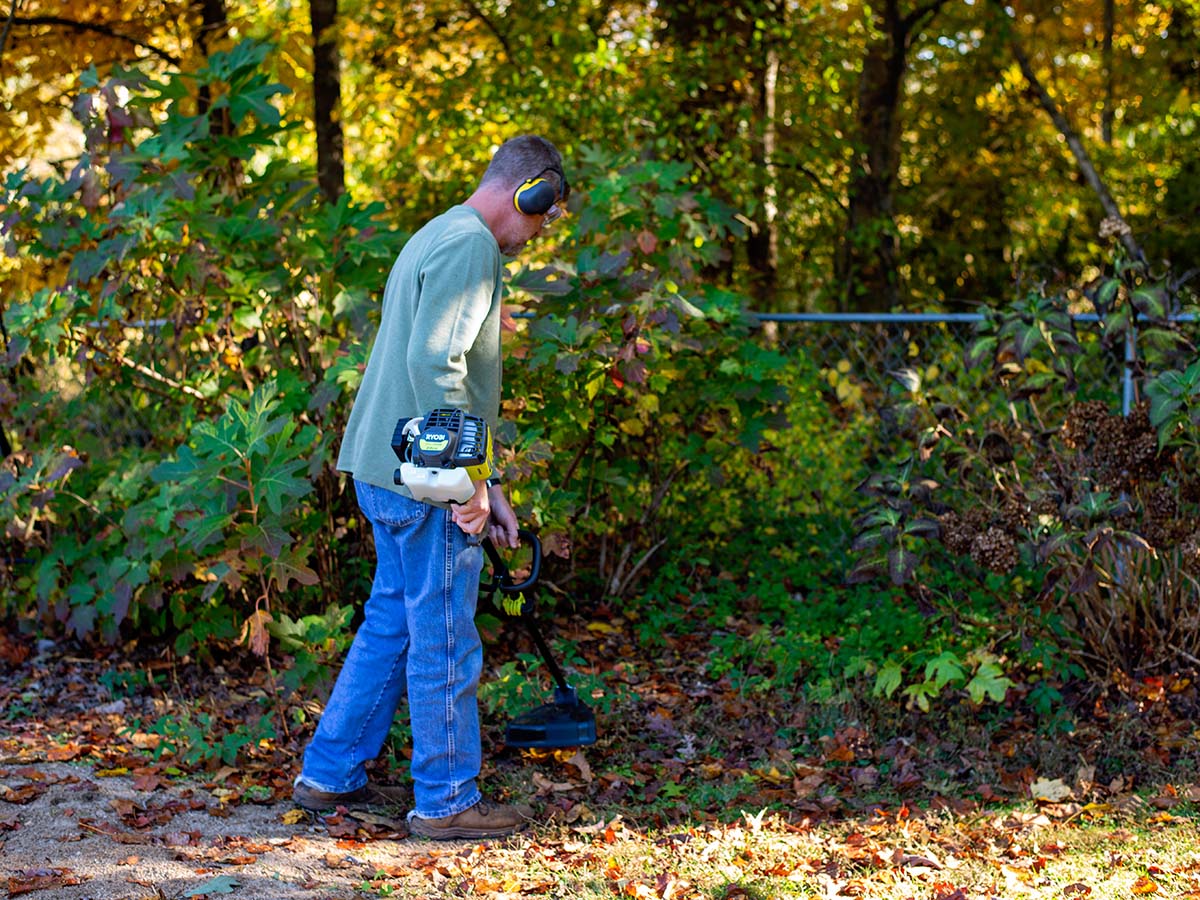
| Testing Stats | |
| Products tested | 8 |
| Time spent testing | 2 days |
| Tests performed | 5 |
| Price range | $170 to $320 |
Our Top Picks
We chose this lineup of gas string trimmers based on the individual safety features, attachments, and engine type as well as product quality and the other important factors mentioned above. We tested the following products in situations DIYers are likely to encounter on their property, and they proved to be among the best gas string trimmers for keeping the yard and garden neatly trimmed.
Best Overall
Echo SRM-225i
What We Like
- i-75 ignition system reduces start-up effort
- Speed-feed head makes adding trimmer line easy
- Spool can’t be wound in the wrong direction
- Anti-vibration design; cushioned front and rear grips
- Compatible with heavy-duty 0.095 trimmer line
What We Don’t Like
- Narrow debris shield can’t protect user from all clippings
Product Specs
- Engine: 21.2 cubic centimeter (cc) 2-cycle
- Shaft: Straight
- Weight: 12 pounds
Our Ratings: Ease of Use 5/5; Performance 4.7/5; Noise 4/5; Value 5/5
This Bob Vila Approved product carries our brand’s highest level of recommendation.

Bob Vila Approved recognizes the household and DIY products that impressed us most in our real-world testing and that exemplify core values of the Bob Vila brand, including craftsmanship, innovation, and value for the dollar. Winners of this designation come recommended by our professional review team and are personally approved by Bob Vila.
Our top pick proves the adage, “You get what you pay for.” The Echo SRM-225i string trimmer costs a little more than some of the competitors we tested, but it delivered the best combination of easy start-up, overall working comfort, and grass trimming power at a reasonable price.
Powered by a lightweight, high-output 21.2cc 2-cycle engine, this trimmer cuts with satisfyingly aggressive results in dense grass and coarse weeds, and uses less fuel than competitors with larger engines. It makes a 17-inch cutting swath and features a speed-feed head that reduces the time it takes to reload the trimmer line by half. The 59-inch straight shaft offers excellent reach beneath shrubs and into tight corners. The weight-balanced design, rubber overmold grip on the handles, and ergonomic throttle trigger reduce operator fatigue for extended use.
No assembly was required to get started with the Echo straight-shaft string trimmer. The position of the fuel tank made it easiest to fill with the motor elevated. Using a 1-gallon fuel can, we held the trimmer in one hand while pouring with the other. We followed the start-up instructions printed on the machine, and it started on the third pull of the recoil cord.
We were pleasantly surprised by the way the smaller-than-average motor powered this trimmer through coarse vegetation and even small, woody stems. Performance exceeded the 25cc trimmers we tested and rivaled the 27cc models. The weight of the motor was well balanced by the long, straight shaft, so maneuvering was very easy and comfortable, even after an hour of use. The rubber grips on the handles deadened any vibration so that we didn’t experience the hand fatigue or numbness that sometimes comes with hours of weed wacking. Though not the most powerful brush-cutting string trimmer we tested, this Echo model makes the best case for general trimming and frequent, larger cleanup projects.
Get the Echo SRM-225i gas string trimmer at The Home Depot.
Runner-Up
Husqvarna 330LK Gas String Trimmer
What We Like
- 27.9cc engine delivers more power for tough cutting conditions
- Spring-loaded smart start and air purge for easier cold starting
- 20-inch-wide cutting swath reduces trimming time
- Compatible with Husqvarna power-head attachments
What We Don’t Like
- Heavier than comparable string trimmers
- Spring-assisted ignition not as easy to start as some
Product Specs
- Engine: 27.9cc 2-cycle
- Shaft: Straight; attachment capable
- Weight: 12.79 pounds
Our Ratings: Ease of Use 4.3/5; Performance 5/5; Noise 5/5; Value 4/5
The Husqvarna 330LK gas string trimmer offers heavy-duty capability for trimming, edging, and other yard care tasks. It features an attachment-compatible shaft that comes with the high-capacity Rapid Replace trimmer attachment and is compatible with lawn-edger, hedge-shear, and pole-chainsaw attachments. Spring-assisted recoil starting, a powerful 27.9cc 2-cycle engine, and customizable trimming swath make this multitasking trimmer one of the top performers in our tests.
While it offered similar reach and power benefits as the other straight-shaft trimmers, the Husqvarna attachment-capable trimmer stood out in our tests in terms of controls and overall feel. The auto-return on/off switch defaulted to the “on” position, and the pull-out choke lever made it obvious which position was for cold starting versus running—two points of confusion on many trimmers.
The spring-assisted recoil starter took some getting used to. There was a catch point mid pull, before which we could feel resistance slightly intensifying, but afterwards the power-assist mechanism released. Overall, starting was easy (never more than three pulls), and the motor ran relatively quietly (although we wore over-the-ear hearing protection for the tests).
Powered by the largest motor in our test group, the trimmer did a fantastic job cleanly snipping the tops of wayward grass blades and hogging through heavy overgrown weeds. The vibration-dampening system seemed to reduce hand fatigue, but after an hour of operation, the machine’s weight was more tiring overall than the other trimmers. Adding a harness system could help for bigger jobs. This model seemed like a really good fit for those who want to get the most production from a single machine, with plenty of power for a wide range of tasks.
Get the Husqvarna 330LK gas string trimmer at Amazon or Tractor Supply Co.
Best Bang For The Buck
Ryobi 2-Cycle Straight Shaft String Trimmer
What We Like
- Ample power for trimming and edging
- Suitable for both thick and thin plant and grass varieties
- Works with hedge-shears, lawn-edger, or pole-chainsaw attachments
- Easy to maneuver into hard-to-reach areas
What We Don’t Like
- Loud operation; more vibration than more expensive models
- Narrow mouth makes filling tank difficult, increases chance of spills
Product Specs
- Engine: 25cc 2-cycle
- Shaft: Straight; attachment capable
- Weight: 12.2 pounds
Our Ratings: Ease of Use 4/5; Performance 5/5; Noise 4/5; Value 3.3/5
For those just starting to build their outdoor power-tool collection, a reliable and budget-friendly choice makes sense. The Ryobi straight-shaft string trimmer delivers plenty of power to knock down grass and weeds, and it’s attachment capable for punching out more yard chores beyond just trimming.
This trimmer features a 25cc 2-cycle engine and includes the “reel-easy” rapid-loading weed eater head. The shaft is compatible with Ryobi expand-it attachments, including the lawn edger, cultivator, pole chainsaw, leaf blower, and hedge shear, sold separately.
The Ryobi string trimmer was ready to go within 5 minutes. Out-of-the-box assembly required attaching the debris guard above the cutting head and inserting the attachment into the power-head shaft. When we added fuel, we noted that the tank’s opening was quite small, so we had to pour very carefully (or use a funnel) to avoid spills. Also, the opening is oriented horizontally, which could pose a leak problem with age but was not a problem for us.
For the low price, we were impressed with this trimmer’s performance. It tore through weeds and grass with a similar effect as the more expensive models. But this machine was significantly louder and vibrated more than the pricier competition. We also noted that the Ryobi was one of two machines in our tests that did not run a full hour on a single tank of fuel—we had to refuel at about 55 minutes. But for anyone on a budget, this weed wacker makes quick work of trimming jobs and may save money and storage space when other attachments are added.
Get the Ryobi gas string trimmer at The Home Depot.
Best Commercial
Stihl FS 70 R Grass Trimmer
What We Like
- Very lightweight; easy to maneuver
- Carry strap for comfort with extended use
- Protected choke lever reduces risk of damage in transport
- Easy-access air filter for quick clean out or replacement
- High-power engine and excellent fuel economy
What We Don’t Like
- Premium price point
Product Specs
- Engine: 27.2cc 2-cycle
- Shaft: Straight
- Weight: 10.6 pounds
Our Ratings: Ease of Use 5/5; Performance 5/5; Noise 4/5; Value 4.3/5
Even at a premium price point, landscape pros and commercial property managers choose Stihl string trimmers and brush cutters for their combination of power, durability, and operator comfort. The Stihl FS 70 R commercial-grade straight-shaft string trimmer features a fuel-efficient 27.2cc 2-cycle engine to go along with its rugged but lightweight polymer housing. To protect the environment and the health of workers, this trimmer earns the Stihl “Caring For Nature” rating as a low-emissions trimmer that operates cleaner than U.S. Environmental Protection Agency (EPA) requirements.
Among the trimmers we tested, the Stihl models were more expensive and a little harder to get, but they were worth it. Stihl only sells through its network of authorized full-line servicing dealers, so online ordering is limited and home delivery is generally not available. But the process eliminates out-of-the-box start-up problems because a certified technician assembles, tests, and adjusts the machine at the dealership prior to customer pickup.
Our first note on this trimmer was that the fuel-fill opening is conveniently wide and extremely easy to access, even while the machine is resting flat on the ground. For our tests, the FS 70 R started on the first pull. It ran noticeably smoother than any of the other machines, both at idle speed and at full throttle, with delay-free acceleration when triggered. The trimmer cut cleanly through tall grass and densely overgrown weeds without getting wrapped up or bogged down in debris. As for fuel efficiency, even with the modest 11.5-ounce fuel tank, we were able to trim for a full hour without stopping to refill. The AutoCut trimmer head was fast and easy to respool without disassembly.
Another point for consideration was the overall operating comfort. Not only was the FS 70 R the lightest straight-shaft trimmer we tested, but it also came with a shoulder strap that transferred all of the machine’s weight away from the hands. As a total package, this would be our machine of choice for all-day trimming on large properties.
Get the Stihl FS 70 R gas string trimmer at Ace Hardware or Northern Tool + Equipment.
Best Curved-Shaft
Husqvarna 130C Curved Shaft String Trimmer
What We Like
- Surprisingly quiet operation for such a powerful engine
- Plenty of power to whack coarse weeds and thick grass
- Curved shaft is comfortable for users under 6 feet tall
What We Don’t Like
- Slight delay between triggering and trimmer-head reaction
- Heavier than the Echo and Stihl curved-shaft trimmers
Product Specs
- Engine: 27.9cc 2-cycle
- Shaft: Curved
- Weight: 11.31 pounds
Our Ratings: Ease of Use 4/5; Performance 4.3/5; Noise 4/5; Value 4/5
This Husqvarna cordless gas trimmer has a curved-shaft design that is intended to make it easier to cut parallel to the ground. The trimmer features a bump feeding system, enabling the user to extend the grass trimmer string from the dual-line head by tapping the trimmer head against the ground.
The 2-cycle gas string trimmer is a good option for homes with small to medium yards, as it weighs just 11.31 pounds and has a 17-inch cutting width. It protects the user with a debris guard cleverly designed with a narrow extension from the shaft widening to a broad, protective shield; this combination makes it easier to see where the trimmer is cutting without sacrificing safety. The trimmer also has a trigger safety switch, which must be activated before the variable-speed trigger will respond, helping prevent accidental start-ups.
The Husqvarna curved-shaft gas edge trimmer weighed less than most straight trimmers but a little more than the other curved-shaft trimmers in our tests. It arrived ready to work, with no assembly required. After filling the fuel tank, it started on the third pull and delivered powerful and surprisingly quiet performance.
The molded fuel cap was easy to grip, and the tank mouth was wide enough to fill easily. We found it convenient to rest the engine on an elevated surface for refueling. The spring-assisted recoil starter made starting easy—typically on the second pull in our tests. The trimmer easily mowed down all of the coarse weeds and thick grass in its way. We loved the responsiveness of the bump cutting head, which seemed to feed more easily than most of the other trimmers we tested. For curved-shaft enthusiasts with small to midsize yards, this could be a great choice.
Get the Husqvarna 130C gas string trimmer at Amazon.
Best Lightweight
Stihl FS 40 C-E Gas String Trimmer
What We Like
- Budget-friendly price for industry-leading performance
- Very lightweight; includes shoulder strap
- Easily cuts through dense grass and coarse weeds
- Very low exhaust emissions
What We Don’t Like
- Shoulder strap maybe not long enough for taller users’ comfort
Product Specs
- Engine: 27.2cc 2-cycle
- Shaft: Curved
- Weight: 9.9 pounds
Our Ratings: Ease of Use 4.7/5; Performance 4.3/5; Noise 5/5; Value 4.3/5
Curved-shaft trimmers are touted for the weight reduction that comes from a shortened shaft, but they often place more weight on the user’s rear hand, which can increase operator fatigue. Weighing less than 10 pounds, the Stihl FS 40 C-E gas string trimmer pairs the lightest design in our roundup with a shoulder strap that transfers the load to the operator’s core. The result is a major upgrade in extended-use comfort for curved-shaft trimmer users.
This machine also excels in trimming performance. The 27.2cc engine runs clean and smoothly, delivering commercial-grade cutting power, excellent fuel economy, and low exhaust emissions. It has earned Stihl’s “Caring For Nature” seal for exhaust emissions that outperform EPA standards.
We were pleasantly surprised by the bargain price on the Stihl curved shaft trimmer. It was worth every penny. As with the other Stihl trimmer on our list, this model was assembled and tested at the dealership before we picked it up. Both machines are built with the same engine type.
The FS 40 C-E started on the first pull and tore through all of the grass and weeds in its way without hesitation. The engine ran and accelerated very smoothly throughout testing, with a crisp response to triggering. We cannot overstate the value that a shoulder strap adds to this curved-shaft design. The other curved trimmers we tested left us with heavy right arms from carrying the weight of the motor after an hour of trimming, but this Stihl did not. In fact, the shoulder strap increased overall maneuverability by providing a pivot at the attachment point. Arm and shoulder muscles were used only to guide the direction of the trimmer. This makes an excellent pick for any curved-shaft trimmer user, especially for those faced with hours-long jobs.
Get the Stihl FS 40 C-E gas string trimmer at Ace Hardware.
Honorable Mention
Craftsman 25cc 2-Cycle Straight Shaft Gas Trimmer
What We Like
- Lowest price point of all trimmers we tested
- Ample power for grass trimming and weed wacking
- Attachment-capable shaft compatible with numerous yard care tools
- Easy winding bump head for fast trimmer-line reloads
What We Don’t Like
- Heavier than most of the other trimmers we tested
-
Larger engine but less perceived power than Best Overall
Product Specs
- Engine: 25cc 2-cycle
- Shaft: Straight; attachment capable
- Weight: 12.8 pounds
Our Ratings: Ease of Use 4.3/5; Performance 5/5; Noise 4/5; Value 4/5
At 12.8 pounds, this gas string trimmer is considered lightweight, but it weighs a bit more than most of the competitors we tested. It features a dual-line head that cuts a 17-inch swath, making this trimmer a good choice for yards up to 1 acre or for any locations where landscaping and lawn ornaments demand precision trimming.
The trimmer comes with a debris guard and has a multiposition handle that can be adjusted to the user’s preferred position for better control and comfort. It also features a bump feeding system so the available line can be extended by simply tapping the head on the ground. This trimmer has a straight shaft, and the head can be removed to make string loading easier. It works with other Craftsman trimmer attachments, which are not included.
In our tests, the Craftsman trimmer performed similarly to the Ryobi. Both featured no-frills design and powerful cutting action, and both were priced near the low point among our test group. Installing the debris guard and loop handle took about 5 minutes. We added fuel and were ready to start. This was the only trimmer we flooded by overpriming while attempting to start the first time. After waiting a few minutes, it started on the fourth pull.
The 25cc motor provided ample power to cut through thick grass and weeds. The cutting head was easy to reload with a new trimmer line. The machine ran a bit louder than the other trimmers we tested, and we felt more vibration in the handles. Still, because of its modest price, and especially because of its ability to power other tool attachments, this Craftsman string trimmer has a lot to offer budget-conscious shoppers.
Get the Craftsman gas string trimmer at Lowe’s.
Also Consider
Echo GT-225 Curved Shaft String Trimmer
What We Like
- Smooth-running, surprisingly powerful 21.2cc 2-cycle engine
- Easy to maneuver in small landscapes
- Durable and fuel efficient
- Simple cutting-head design makes it easy to reload
What We Don’t Like
- Uses precut trimmer line that requires work stoppage to reload
Product Specs
- Engine: 21.2cc 2-cycle
- Shaft: Curved
- Weight: 10.1 pounds
Our Ratings: Ease of Use 4.3/5; Performance 4.3/5; Noise 5/5; Value 4/5
The Echo GT-225 string trimmer makes yard work easier thanks to its lightweight curved-shaft design and professional-grade 21.2cc 2-cycle engine. Weighing just over 10 pounds, this trimmer is easy to carry and highly maneuverable—an ideal build for smaller yards. The two-line rapid-loader cutting head trims a 16-inch swath and uses precut trimmer line for easy line changes.
The GT-225 curved-shaft trimmer arrived ready to work and no assembly was required. After adding fuel, which worked best with the engine resting on an elevated surface, it was ready to go. We noted that this Echo trimmer is powered by the same engine type as our Best Overall pick. It started easily on the second pull, accelerated smoothly, and delivered cutting power seemingly beyond its 21.2cc engine displacement.
As with the Husqvarna curved-shaft trimmer, the shorter shaft left a greater proportion of the machine’s weight in the operator’s rear hand. But the lighter overall weight made it a bit less tiring. One aspect of this trimmer that really stood out was the unique cutting-head design. It uses fixed pieces of trimmer line instead of feeding from a reserve spool. It cuts well, but when the trimmer line wears down, the operator must stop and reload. This design is most practical for small yards where multiple reloads will not be required.
Get the Echo GT-225 gas string trimmer at The Home Depot or Blain’s Farm & Fleet.
Jump to Our Top Picks
What to Consider When Choosing a Gas String Trimmer
A string trimmer is a powerful tool equipped with weed-eater string to cut through overgrown grass and weeds quickly. For help deciding on the best gas string trimmer for your home’s landscaping, consider the following criteria: engine type, fuel efficiency and runtime, cutting width, feeding and loading, speed, ease of use, attachments, and safety features.
Engine Type
Gas-powered weed eaters fall into two categories based on the type of engine they use: 2-cycle or 4-cycle. This seemingly simple difference creates significant gaps between efficiency, cost, maintenance, and power.
- 2-cycle engines are lightweight, allowing you to move more freely while working with the trimmer. Two-cycle engines use a fuel-and-oil blend, which reduces average maintenance to changing the weed-eater string and emptying the fuel tank before storing the trimmer for the offseason. Though lower maintenance, these trimmers have less power output than those with a 4-cycle engine.
- 4-cycle engines are generally considered more efficient than 2-cycle engines. The efficiency comes at the cost of size and weight, so users can expect a heavier tool when they pick up a 4-cycle engine trimmer. These tools also are more powerful than products with 2-cycle engines, making them a good choice for yards that are more than an acre. However, products with 4-cycle engines typically cost more and require regular oil changes to keep them working properly.
The size of the engine is another important factor. This is measured in cubic centimeters. As an engine increases in size, as indicated by the cc, the power output of the engine increases. This is because a larger engine is generally capable of displacing more air and fuel at one time. When displacement is low, power output is also low. So if high power is the goal, look for a product with an engine larger than 40cc.
Fuel Efficiency and Runtime
Fuel efficiency can be difficult to gauge, as there are a number of different factors that can influence it, including the mixture of gas for the weed wacker, ambient temperature, operating speed, and even the type of grass or weeds being cut. However, a gas string trimmer with a 4-cycle engine will usually be more efficient than a trimmer with a 2-cycle engine.
Runtime is a bit easier to measure because manufacturers typically provide the fuel-tank size and the maximum runtime on a single tank of fuel. These runtime numbers are based on tests performed in ideal, controlled environments, so factors like high- and low-temperature extremes or very dense, wet foliage can reduce the actual runtime. These situations decrease the fuel efficiency of the trimmer, causing it to use more fuel in a shorter period of time.
Cutting Width
The cutting width of a gas string trimmer refers to the total width the rotating string can reach when the trimmer is in use. Standard gas string trimmers will have a cutting width of about 16 to 18 inches. However, there are compact models that may be as small as 12 inches wide, and commercial gas string trimmers can exceed 20 inches wide, so it’s important to know what size is necessary for your lawn, yard, and garden.
Yards that exceed an acre and have very few small obstacles may benefit from a gas string trimmer with a cutting width of 18 inches or more, while yards that are smaller than 1 acre are fine with gas grass trimmers that have a smaller cutting width. Users with many obstacles in their yard may prefer a smaller cutting width so they can have more precise control. For cutting through deep, dense weeds and overgrown grass, it’s helpful if the cutting width is big and the engine is powerful.
Variable-Speed Control
The speed of a gas string trimmer is controlled by a variable-speed trigger that can either be placed on the shaft of the tool or on one of the handles (if the model has a split-handle design). Trigger placement on the right handle may cause problems for left-handed users. When the trigger is on the shaft of the trimmer, it’s relatively easy to use either hand to control the speed while the other hand controls the movement of the trimmer head.
Variable-speed control allows the user to reduce the speed for light trimming or increase the speed to cut through dense brush and weeds more rapidly. The ability to dial down the speed for precision control is great while trimming around lawn ornaments, garden beds, and along fencing to reduce the potential damage that can be caused by less controllable trimmers.
Loading and Feeding
Loading and feeding the line tend to be the most challenging parts of using a gas string trimmer. Loading refers to installing the cutting string, which can be difficult, especially when dealing with a dual-line head that has two weed-eater strings. To help make this task easier, shoppers will want to consider products with a detachable head so they aren’t fighting with the entire trimmer while trying to change the line.
Feeding the line refers to pulling more line out of the trimmer head. There are now many products that offer innovative line-feeding methods that eliminate the need to start and stop while using the trimmer to deal with a standard fixed line. These include bump feeding and auto feeding.
- Fixed-line gas string trimmers are attached tightly to the head, meaning you’ll want to loosen the head and manually pull the line out when more is needed.
- Bump feeders are designed to push out more string when the head is bumped on the ground or on another hard object so the user needn’t stop to extend the string.
- Auto feeders have a prewound head that automatically feeds string using centrifugal force, so the string is constantly self-correcting to the ideal length.
Ease of Use
Using a gas string trimmer can be tiring, but several factors can help make the work easier. These include the angle of the shaft, the weight of the string trimmer, the balance of the trimmer, and the trimmer head.
- The shaft of the trimmer can either be completely straight or curved. Curved shafts are great for getting a flat angle cut over a broad area without having to bend and twist to change the cut of the trimmer. Straight shafts are better for detailed trimming between and around lawn ornaments.
- The weight of a trimmer can tire the user, especially if they’re working in a very large yard or dealing with many different precision cuts. Additional time spent trimming can lead to aching arms and shoulders, so a lighter trimmer of 10 to 12 pounds may be a better option. If the power of a heavier trimmer is needed, then work breaks may be necessary to avoid injury.
- The balance of the gas string trimmer is dependent on how the weight of the engine, focused at the rear of the tool, compares to the weight of the rest of the trimmer, which is dispersed along the entire length of the shaft down to the head. Unfortunately, balance is difficult to determine without actually holding the tool, so be sure to read product information and hands-on reviews, such as the ones that appear here, to get a good idea of how the trimmer handles.
- The trimmer head can come with a variety of attachments detailed below. It can also have a versatile tilting feature that allows the head to be angled up or down for more precise cutting in tight spots.
Attachments
When using a gas string trimmer to clean up the yard and garden, it’s possible to encounter sticks, leaves, and debris; the trimmer is useless to deal with these unless it comes with an edging tool, saw, blower, or brush attachment.
- Edging tools are useful for creating a defined edge between the garden and the lawn or the lawn and the sidewalk or driveway. They have a more powerful cutting blade that makes quick work of overgrown grass, which saves the time and effort of using a shovel to edge the lawn.
- Saw attachments are a great choice for cutting through sticks and brush that have fallen during the fall and winter seasons. While it shouldn’t be used for cutting through logs or planks of wood, the saw moves easily through small branches and twigs.
- Blowers are a separate tool, but sometimes they are packaged as a kit with a trimmer. They help quickly clean up a mess made by trimming, edging, and cutting.
- Brush attachments can help clean up a messy sidewalk or driveway, pushing the yard debris into a pile or just brushing stray grass and dirt back onto the lawn.
Safety Features
Before picking up a gas string trimmer, it’s important to remember that this device is designed for cutting through layers of the tough cellulose fiber of plants while hitting walls, rocks, metal, and wood at an impressive speed. It is a machine that should always be handled with proper precautions. With this in mind, look for gas string trimmers that have safety features like a debris guard, a trigger switch, and a padded grip.
- Debris guards are included with almost every gas string trimmer because they are essential to protecting the user. Even with a guard, some flying grass can escape, which is why users will want to wear safety glasses, long pants, and closed-toe shoes while working.
- Trigger switches are designed to prevent the trimmer from being accidentally turned on. The trigger switch must be held down before the trigger will activate the trimmer.
- Padded grips on the shaft and handle of the gas string trimmer will help reduce hand fatigue and muscle strain that can be caused by excessive vibration. The padding also makes the tool easier to hold and helps prevent it from slipping out of the user’s hand while trimming.
FAQs
If you’re still unsure about some of the details surrounding gas string trimmers, read the following answers to some of the most commonly asked questions about how to use these trimmers as well as how to store and maintain these machines for years of use.
String trimmers are invaluable tools when it comes to keeping your yard looking tidy. Not only does the landscaping look better, but using a string trimmer can prevent water damage and staining on fences, sheds, and garden-bed edging blocks.
When trying to decide on the right size trimmer, consider the size of the yard, the number of obstacles in the yard, and the type of obstacles. Generally, larger yards without many obstacles will be easier with larger gas string trimmers. Yards with gardens, low-hanging plant leaves, lawn ornaments, and fences are better handled with a smaller trimmer.
To keep it safe from hot- and cold-temperature extremes, precipitation, and debris, store a cordless string trimmer off of the floor inside a workshop or garage. This can be done by hanging the gas string trimmer on the wall using two or more hanging hooks. Make sure to empty the gas from the trimmer before storing for the offseason.
Gas string trimmers can last about 5 to 10 years, with some difference in longevity depending on how the trimmer is stored and if it is maintained properly.
It depends on your needs. A curved string trimmer is lighter and provides better balance. However, a straight trimmer works more effectively on heavy-duty jobs.
It depends on how frequently you use your string trimmer, but greasing it once per year is usually adequate.


